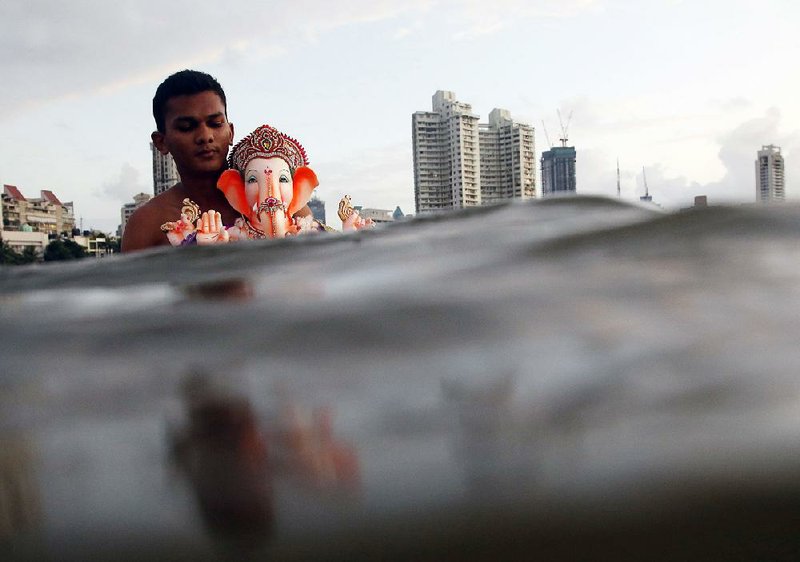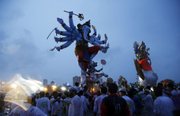MUMBAI, India -- The couple approached the 14-foot statue of the god Ganesh last week, hands folded, believing with all their hearts in his powers as the one who removes obstacles.
They had seen proof of this two years ago, they said, when they prayed during the Ganesh festival for their daughter to become pregnant. The daughter, who lives in Britain, now has a child.
Perhaps not all that miraculous, but enough to convince the couple, Farida and Jimmy Balsara, who are not even Hindu. Every year, along with tens of millions in street festivals across India, they celebrate the power of Ganesh, the elephant-headed god who has been adopted by some of the country's other faiths. The festival is particularly popular in Mumbai, the megalopolis of 20 million that is India's industrial and film capital, where it got started in the 19th century as a protest against colonialism.
And so the Balsaras, who, as Parsees, are followers of the Iranian prophet Zoroaster, are among the crowds who pray for Ganesh's blessing. The giant plaster-of-paris statue of Ganesh before them is the most famous in Khetwadi, one of Mumbai's oldest, densest neighborhoods, near where the festival was first celebrated.
Almost every alley features yet another wildly decorated, ardently worshipped Ganesh. But this one, Khetwadi Cha Ganraj, or the Ganesh of Khetwadi, often wins awards as the most beautiful. That fame drew the Balsaras and thousands of others on Sept. 14, the last day before the deity would join about 50,000 other statues across the city in a procession of dancing crowds to the ocean, where the idols were gently lowered into the water.
More than 160,000 Ganesh statues had already been dropped in the city's waterways, some just a foot tall and worshipped in people's homes, others close to 30 feet high, paid for by politicians and business people as centers for worship and merriment at the festival.
Worship of an elephant in the Indian subcontinent can be traced to about 325 B.C., with Ganesh becoming part of the Hindu pantheon around the fifth century, and then being absorbed into Buddhism and Jainism in the ensuing centuries.
Despite the surrounding city, the community has maintained its village feel. During the festival, the courtyard in the chawl was an oasis of calm in the midst of all the urban hustle. Children ran in and out of the apartments, most of which had their doors wide open; women wearing saris cooked dinner; and men in shorts napped and watched TV.
"You can just enter anyone's room," said Vinod Satpute, a 58-year-old flight attendant with Air India, whose parents moved to the chawl decades ago. "It doesn't matter if he's eating or sleeping. That's his problem."
A few streets down, vast crowds gathered around the Khetwadi Cha Ganraj. The first statue went up here in the neighborhood's Lane No. 12 in 1959, and this year's celebration cost close to $75,000, financed in large part by corporate donations.
The costs cover not just the giant, elaborately painted and dressed Ganesh, but also the themed room that holds the deity -- this year, a "Rome and Rajasthan palace." Two huge chandeliers hang overhead as 12 speakers boom temple music at a deafening volume. A crane holds a video camera that beams live footage to a smartphone app and to a YouTube site.
In addition to many flower garlands, this Ganesh wears a 33-pound necklace of pure gold, the gift of an anonymous donor in 2008, said Ganesh Mathur, who was among those in charge of the Khetwadi Cha Ganraj this year.
Along the street, almost every alley has been transformed into a tent with an enormous Ganesh inside. Crowds throng, buying cotton candy, toys, tea and watermelon slices, as couples and families make a day of visiting the idols. Lines snake around almost every tent, inside of which crowds gape at the latest iteration of the revered god.
At the Khetwadi Cha Ganraj it was time for the evening prayers. As they finished, workers on ladders used peacock feathers to dust Ganesh's massive arms and pink fingernails. Then they began replacing the deity's many flower garlands with fresh ones.
At that, the Balsaras, until now engaged in deep prayer at the back of the room, rushed forward and shouted to the attendants over the temple music that they wanted to take the discarded garlands home.
Jimmy Balsara, 77, and Farida Balsara, 64, said they had not been able to think of any major family or business problem that needed overcoming, so this year they offered more general prayers, wishing happiness for everyone.
In minutes, they were weaving their way through the motorcycles and street vendors outside, arms buried in red and white flowers, convinced that another great year lay in store for them and for everyone else.
Religion on 09/24/2016


